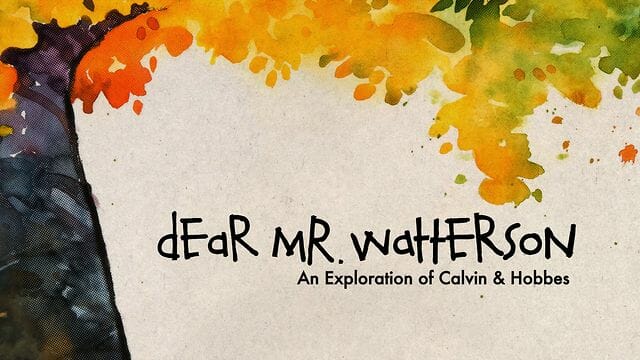
Dear Mr. Watterson illustrates what can happen when a passionate young filmmaker decides to put together a documentary that pays tribute to one of his childhood totems. A warm salute to the acclaimed comic strip Calvin and Hobbes—and, tangentially, its creator Bill Watterson—the full-length debut of director Joel Allen Schroeder does an impressive job gathering plenty of talking-head interviews from notable individuals in the comics world, although not from the press-shy Watterson himself. But even if you share Schroeder’s abiding love for this strip about a troublemaking boy and his loyal tiger, you may still wish that he hadn’t approached the material with such wide-eyed enthusiasm. Dear Mr. Watterson has a lot of passion but just barely enough insight.
Launched in 1985, Calvin and Hobbes followed the exploits of Calvin, an only child, and his stuffed tiger doll Hobbes, whom comes to life in Calvin’s imagination. Ten years later, the strip ended, leaving behind a legacy as one of the funny pages’ most innovative and gorgeously rendered cartoons, mixing wry humor with a wistful philosophical bent. Since the final strip on New Year’s Eve 1995, Watterson has mostly stayed out of view, something of a J.D. Salinger of the comics world. That shunning of publicity, along with his refusal to turn Calvin and Hobbes into a cash cow by rejecting lucrative licensing offers, has only heightened Watterson’s artistic stature. In a world of mostly disposable strips contained within the pages of shrinking newspapers, Calvin and Hobbes (alongside a few other notables such as The Far Side) remains culturally significant—maybe even more so now than during its celebrated run.
For people like Schroeder, Calvin and Hobbes is also meaningful because it came around during their upbringing. The strip’s portrayal of the big, scary world, which was reflected through the eyes of an impressionable kid, served as a handy guide to young people at the cusp of their own adolescence. So it shouldn’t be a surprise that Dear Mr. Watterson has all the geeky, fawning, slightly embarrassing energy you tend to witness when star-struck fans meet their heroes at red-carpet premieres. Narrating Dear Mr. Watterson and structuring the interviews around his personal story to get to the bottom of why Watterson’s work resonates with so many people, the milquetoast Schroeder doesn’t have the perspective to recognize that—an utterly nice guy though he may be—he’s not nearly entertaining or compelling enough to be the focal point of a documentary.
The early stretches of Dear Mr. Watterson are particularly worrisome as Schroeder details how he got into the strip and why he’s decided to visit Watterson’s Cleveland suburb to get a sense of the environment that shaped Calvin and Hobbes’s sensibility. Thankfully, Dear Mr. Watterson establishes quickly that it won’t be trying to track down Watterson to wring an interview from the man. But even then, the documentary can be awfully precious and pushy as Schroeder travels to Watterson’s archives at the Ohio State University, forcing the viewer to be interested in witnessing Schroeder’s excitement at seeing the cartoonist’s original drawings. Too much of Dear Mr. Watterson is about the filmmaker’s journey, which lacks the twists or riveting storyline that would justify its inclusion.
However, much is redeemed by the people Schroeder interviews. Practically a who’s-who of notable cartoonists, Dear Mr. Watterson is best when Watterson’s peers and modern-day torchbearers analyze his work, offering an expertise that Schroeder doesn’t possess. Stephen Pastis, who draws Pearls Before Swine, discusses Watterson’s decision not to license Calvin and Hobbes, and while he sympathizes with Watterson’s reasons, he also makes a convincing argument for why it might also have been shortsighted. Berkeley Breathed, the man behind Bloom County, is quite eloquent explaining how the comics page has negatively evolved since Calvin and Hobbes, shifting toward tinier strips that deemphasize the artwork. (The glorious large-scale Calvin and Hobbes Sunday strips have mostly gone the way of the LP.) And different historians and critics smartly place Calvin and Hobbes within the trajectory of comics in the 20th century, pointing out its antecedents, such as Peanuts, but also demonstrating how Watterson fought to gain respect for what cartoonists do.
When Schroeder makes Dear Mr. Watterson less about himself, the film opens up to become an engaging study of a misunderstood, often dismissed art form. Responsible for coming up with funny strips on a daily basis that can appeal to a large mainstream audience, cartoonists must be a combination of storyteller, entertainer and stand-up comedian, trying to stay faithful to a dependable formula while flirting with experimentation to keep things fresh for themselves and their audience. That in such a pressure-cooker environment Calvin and Hobbes didn’t just blossom but thrive is something of a miracle. That’s the central message of Dear Mr. Watterson, and it’s an important one, even if the messenger leaves something to be desired.
Tim Grierson is chief film critic for Paste. You can follow him on Twitter.
Director: Joel Allen Schroeder
Starring: Joel Allen Schroeder, Berkeley Breathed, Stephan Pastis, Bill Amend, Seth Green
Release Date: Nov. 15, 2013